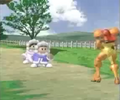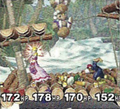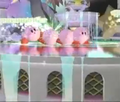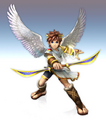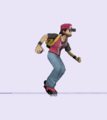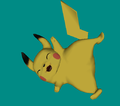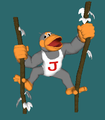Unused content: Difference between revisions
(page is over mobile warning threshold now, so resuggesting split from August 2011) |
|||
| Line 293: | Line 293: | ||
|snd_bgm_A12_MORINOKINOKO | |snd_bgm_A12_MORINOKINOKO | ||
|''Mario'' | |''Mario'' | ||
|Japanese translates to "Mushroom Forest"; | |Japanese translates to "Mushroom Forest"; 'Due to its position in the list, which follows a general chronological trend, it is likely this track was the theme for Toadwood Forest, also from Partners in Time. It would have been yet another theme for the underground version of the Mushroomy Kingdom stage. | ||
|- | |- | ||
|snd_bgm_C06_KAZENOSAKANA | |snd_bgm_C06_KAZENOSAKANA | ||
| Line 399: | Line 399: | ||
It is unknown if they were meant to be used as background music, or as fanfares. | It is unknown if they were meant to be used as background music, or as fanfares. | ||
===Scrapped trophies=== | ===Scrapped trophies=== | ||
Some characters have unused trophies with "R2" in the filename, showing them in various poses (most in possible gameplay poses, some not). It is possible that these were intended to be a third trophy for each character, similar to how every character in ''Melee'' has three trophies, and the concept was scrapped for an unknown reason. | Some characters have unused trophies with "R2" in the filename, showing them in various poses (most in possible gameplay poses, some not). It is possible that these were intended to be a third trophy for each character, similar to how every character in ''Melee'' has three trophies, and the concept was scrapped for an unknown reason. | ||
Revision as of 02:06, April 27, 2013
Beta elements are components of the Super Smash Bros. series that, for whatever reason, are removed or altered before that game is released. Known info about beta elements usually comes from one of two sources. The first is information released about a game, by its creators, before the game is complete. The second is data found within the coding of a game that serves no purpose, but could have been implemented into the game at one point.
Super Smash Bros.
Dragon King
Super Smash Bros. was initially developed by Masahiro Sakurai and Satoru Iwata in their downtime, in a form titled Dragon King: The Fighting Game (格闘ゲーム竜王, Kakuto-Gēmu Ryūō), which lacked Nintendo characters. Sakurai, however, felt that the game could not provide the proper atmosphere on a home console without Nintendo characters, and they were soon added and the game was redesigned and renamed. Only four known images of Dragon King exist; no known video footage or working prototypes are known to exist.[1]
Below are the four known images of the game.
Beta gameplay elements
A talk between Masahiro Sakurai and Satoru Iwata states that Sakurai had intended to add Final Smashes in the game. While he did record some dialogue for them, limitations of the Nintendo 64 prevented their inclusion; Final Smashes later became a reality nine years later with the release of Brawl. [2] While the sound effects of these Final Smashes are not accessible through normal play, they can be found through the use of the Debug Menu. These sounds include Ness yelling, "PK Starstorm!", Pikachu charging energy, and Captain Falcon yelling "Come on!". Other characters heard include Kirby and Link. In addition to the unused Final Smash clips, there are two unused Announcer voice clips: "Are you ready?" and "Final Stage." [3]
Beta stages
In the final game, two early stages are only playable with a GameShark; their intended use is unknown, but because they share textures and a background with Dream Land, it has been assumed that the two were meant to be other Kirby stages, or were testing stages before Dream Land's design was finalised. One of these versions, Kirby Beta Stage 2, can be viewed in the "How to Play" tutorial, which itself can be seen by waiting on the title screen.
Saffron City and Dream Land also had minor differences with the final product; the roofs of buildings in Saffron City had a considerably brighter pink texture on them, while Dream Land had considerably darker shades of green, as well as much taller grass in the foreground and background.
Other beta elements
In the character select, the question mark boxes where the unlockable characters Captain Falcon, Ness, Luigi and Jigglypuff have their character portraits, were initially supposed to be colored, instead of the ordinary grey silhouettes with fiery backgrounds that appear in the final game; these coloured boxes matched the player number colours of red, blue, yellow, and green.
Super Smash Bros. Melee
Beta stage design
The game initially only had 10 starter stages: Princess Peach's Castle, Kongo Jungle. Great Bay, Brinstar, Yoshi's Story, Fountain of Dreams, Corneria, Pokémon Stadium, Mute City, and Onett.[4] Stage placement was also different, with Brinstar being on the top row and Corneria being in the middle; furthermore, there were considerably more "?" boxes for secret stages.
Differences between stages are also common; Temple had an elevator on the right side of the stage that does not appear in the final game. Additionally, mysterious brown platforms appear throughout the stage; they don't appear in the final version, though they can be seen in the "Special Movie" video found in the game's Data menu. In the Great Bay, the laboratory was an actual part of the stage, and players could walk inside; in the final version, the laboratory is now a part of the background. Additionally, the platform at the right of the stage initially only had three pillars; the final versions of the game feature five pillars.
Yoshi's Story, Yoshi's Island, and Mushroom Kingdom had different designs altogether; the first had a design where the rightmost walkable part was a plateau followed by a curved path up to another plateau; the second was larger and had more blocks, while the third looked more similar to the Mushroom Kingdom of the previous game.
Onett's basic appearance was identical to the final game, but the music was different; while the identical track ("Bein' Friends" from Mother 1) played, it had a considerably different arrangement. Additionally, the stage initially was called "Eagle Land: Onett" instead of "Eagleland: Onett". Fourside also only had ordinary black and white buildings, rather than the buildings in the final game, which have multi-coloured windows.
Pokémon Stadium also underwent multiple changes; the earliest screenshots show it with a completely blank screen, though some say that these images were taken before the screen was fully programmed. Later screenshots show different element icons in the background screen, which resembled the icons of the Pokémon Trading Card Game.
A different Rainbow Cruise stage has also been observed, with considerably more clouds, a greyer sky, and a different ship design; no gameplay footage, however, has been located of the stage.
An early version of what appears to be Jungle Japes also was observed; the only pictorial evidence of it, however, does not give any information on how it might've been different, save for some grey textures on the floor, as well as a background that looks similar to the finished stage.
Additionally, footage shows the Ice Climbers and Samus appearing to be fighting in what looks like the All-Star Rest Area. The stage is normally not accessible in the final game; additionally, this version has a darker coloured path, a fence that doesn't appear in the final game, and considerably fewer trees. Of note is that this area briefly appears in a early opening (see below), and a slightly altered version can be seen in the final product's opening; Kirby can briefly be seen walking around in the area.
The first stage of the Adventure Mode, Mushroom Kingdom, also looked different; textures on platforms and rocks in the ground are different, and there are considerably more trees along the path.
Through an Action Replay, multiple other early stages can be found, leftover from testing. One of the stages is a large, gray stage, with the background appearing to be some kind of pub. The music is the same as used on Fox and Falco's stage Corneria. The stage's purpose is outlined by its ; the background image is also a common image to use in OpenGL testing.
In addition to TEST, there exist four other stages: AKANEIA, IceTop, 10-2 and DUMMY. All four will immediately crash the game if they are accessed normally, though other hacks allow some stages to be used. AKANEIA was likely a Fire Emblem themed stages, as it shares the name with the primary setting of the first Fire Emblem game, which also starred Marth. However, even with hacking, no one has successfully accessed the stage. DUMMY, when hacked into, is simply a black background with a lone invisible platform. IceTop and 10-2 are both simply Icicle Mountain, albeit without the music; IceTop's use remains unknown, but 10-2 was to act as another Ice Climbers stage in the Adventure Mode, as 10-1 is the internal name for the Ice Climbers stage in the Adventure Mode.
Finally, Sheik seemingly was originally planned to have her own Target Test stage, separate from that of Zelda; the remnants of the stage, however, consist only of a single dark grey platform and three targets.
Two platforms from the Temple stage that appear in the Special Movie but not during gameplay.
Early versions of Pokémon Stadium had blank screens.
Yoshi traverses a early Mushroom Kingdom in the Adventure Mode.
A panorama of the test level.
- BetaSheikTargetTest.png
Sheik's early Target Test stage.
While the overall menu system remains relatively unchanged from the final version, differences still exist. In the Main Menu (originally called the "Top Menu"), the Trophies, Options, and Data menus were all blanked out with "?"s. In the Multiplayer menu, Special Melee is also blanked out; furthermore, the panel to the right of the menus, which shows the next screen, looked considerably different.
The Lottery had a radically different design; the actual machine looks considerably larger and had more details behind it, such as a model ship, a roulette wheel and a craps table.
The character select screen also underwent many differences during development. The earliest character select screens did not have characters arranged in a rectangle, instead being stacked and "leaning" to one side. While the amount varies in different images, in all cases, the number of selectable character initially began at a number below fourteen. Additionally, similar to the original's beta character select screen, the words "Battle Royal" were in the corner instead of "Melee". Finally, the "Press Start" banner on the "Ready to Fight!" band was not located on the banner; it was instead just above the character boxes.
Later versions, closer to the release of the final product, had character select screens looking almost identical to the final product. One image on the Japanese website, however, shows Zelda's character portrait covered by a "?" mark, like other secret characters. As Sheik's playability was revealed before Zelda's, the move is speculated to avoid spoiling the surprise of Zelda's playability.
Finally, All-Star Mode was intended to have intro screens, almost identical to the ones found in Classic. They were ultimately removed, though they are still fully accessible in the Debug Menu. The earliest Classic Mode intros also looked radically different from the final version's; these versions featured no map or background, and the artwork used for the characters differ considerably from the final versions. Later beta Classic Mode intros had slightly different looking icons on the top of the screen for the "map", and the background the characters were on was considerably brighter than the final product's.
A early version of the Lottery interface.
- Super Smash Bros. Melee Classic Mode.png
A near-complete Classic Mode screen.
Beta trophies
Early screenshots showed the Motion-Sensor Bomb to be much different; these screenshots actually showed it to be a Proximity Mine from Perfect Dark rather than the Motion-Sensor Bomb from "TOP SECRET" (actually GoldenEye 007) that appeared in the final game. A screenshot of this Proximity Mine's trophy also shows that the text is almost identical to the final product, save for a few references to Carrington Institute, an area in Perfect Dark. Why the Perfect Dark Proximity Mine was changed to a GoldenEye 007 Motion-Sensor Bomb remains unknown to this day; a common theory put forth claims that the change was due to Perfect Dark's ESRB's rating of M (for audiences of the age seventeen or higher), while GoldenEye 007's ESRB rating, like Melee's, was T (for audiences of age thirteen or higher).
Early versions of the game also had different Topi trophies. While the final version had a vaguely Yeti-looking creature, it originally was a seal-like creature. The seal is believed to have been removed due to the controversial subject of seal clubbing; while a highly volatile topic in North America and Europe, the issue is rarely brought up in Japan.
- MeleeMotionSensorBeta.png
Super Smash Bros. Melee's original Motion-Sensor Bomb's trophy. The design is identical in the Japanese version of the game; note how the bottom also says "Perfect Dark" instead of "TOP SECRET".
- Topitrophy beta.jpg
The original Topi trophy.
Beta gameplay
In Melee's instruction booklet, an image can be seen for Stamina mode's description. In the image, all four characters have over 150 HP of Stamina, which cannot occur in normal gameplay; players in a four-player match always start with 150 HP, and this value cannot be edited.
As seen and heard in the "Special Movie" included with Melee, Peach had a few voice clips that were ultimately unused. In Bowser's vignette, Peach throws a vegetable at him; while doing so, she yells "Yahoo!", which does not occur in normal gameplay. At the ending clips, which show all the characters, Peach's clip features her taunting; however, instead of saying "Sweet!" as per usual gameplay, she instead says "All right!". Similarly, Mario, upon picking up a Hammer in one clip, says "Wah!" while picking it up. In the final game, all characters stay silent when they pick up the hammer.
In gameplay, the Pokémon Ditto was supposed to appear from Poké Balls, turning into the summoner's character and assisting them in battle. It was removed, though it is still left over in the Debug menu; when summoned, however, it simply says "Meta!" after its Japanese name ("Metamon"), spins while stretching vertically, then disappears.
Early screenshots and the "Special Movie" show that characters, if selected by more than one player, could use the same colour scheme; unlike Team Battle, however, there was no change in contrast. This, however, is also assumed to be a result of using Debug Mode to film the Special Movie and choosing for all characters to look identical.
Early screenshots also show that damage percentages initially did not darken the more damage a combatant had taken; in the final build, the numbers gradually blacken as the character's damage goes up.
Here all four players have the same color scheme, impossible in the final version sans glitches.
Unused bonuses
Some Bonuses were left out of the final game, though they can be accessed with an Action Replay. The reason for their removal is unknown.
| Name | Points Given | Requirement |
|---|---|---|
| Barrel Blast KO | x300 | Used a Barrel to KO someone. |
| Crash & Burn | -500 | All Meteor Attacks Missed. |
| Deflector | 1000 | Unknown (presumed to be something to do with reflecting attacks) |
| Green Shell Shooter | x800 | Caused damage twice or more with a Green Shell. |
| Poolshark | x300 | Threw one enemy into another. |
| Red Shell Shooter | x400 | Caused damage 3 or more times with a Red Shell. |
| Ricochet Rifler | x800 | Deflected shot hit an enemy. |
Other beta elements
The opening sequence of Melee was slightly different; the middle section which shows actual gameplay has different animations and characters. It can be viewed here: [2].
Captain Falcon's red costume, which adds a "Blood Falcon" emblem on his back, was originally planned to say "Hell Hawk".
The original boxart for Melee did not feature Link or Pikachu, nor did it feature Mario dodging Bowser's attack; it instead featured Mario being attacked by Bowser's Fire Breath move. The locale featured also has considerably brighter lighting.
- BetaBoxArtMelee.jpg
The original boxart for Melee.
Super Smash Bros. Brawl
Beta gameplay
Some of the series symbols were initially the same as in the previous two games, but they were revised as time went on; the Mario series mushroom icon was refined and given spots, the Poké Ball icon has the top half colored in to properly represent how it is usually red, the Screw Attack icon was given more bends and another outline, and the Yoshi egg's angle was changed, with a slightly different arrangement of spots.
Multiple attacks were also changed between the game's development and release. Kirby's Hammer move is an example; when he uses hammer in mid-air in SSBM, he does a vertical spin, but in SSBB, he does a horizontal spin. In the first trailer, released at E3 and included on the game disc, features him doing the former. Unused animations also exist on the disc showing Kirby walking with the hammer still out, along with an animation of him swinging the hammer; this has been taken as a sign that the hammer Kirby uses was meant to be charged.
In the Nintendo World 2007 trailer, when Fox appears, he has his Blaster in his hand during the whole battle despite the fact in the final release he only uses the blaster when using his standard special move; additionally, animations left in the game data show both Fox and Falco inspecting the environment before putting their blasters away.
Another early element is Link's Spin Attack. In the first and second trailers, it's given the appearance that there are two strikes on top of each other; in the final game, however, there is only one strike. The early Spin Attack also lacked the red overlay on the slashes.
Pikachu's Quick Attack was also altered; in the first trailer it's shown doing 2 "bip" sounds when he gets teleported, however, in the final version the sound from the move is different, and it only makes one sound, on the first teleport.
Snake, in particular, had many differences from the final product. For his grab, in some early pictures, he's shown grabbing some characters with more accuracy than in the final version. One picture shows Snake grabbing Ike from his right arm and mouth, but in the final version his grab move is shown with less accuracy, with every character being grabbed by the head. Snake's mines also were considerably more realistic-looking, sporting a drab, dark grey-green look instead of the light grey seen in the final game.
In trailers, characters were also shown to be KO'd via the colourful explosion when they crossed the upper blast line. In the final game, normal characters can only be KO'd this way in the Subspace Emissary.
E for All 2007 had a playable demo of Brawl available. This demo was lacking several starter characters: Kirby, Zelda/Sheik, Pokémon Trainer, Ice Climbers, King Dedede, Wario, Olimar, and Lucas are all starters in the final game, but were unavailable in the demo. The demo did, however, allow Sonic to be playable from the start.
By examining the textures of certain characters, it is shown that visible battle damage was at one point planned to be in the game, as evident by such unused textures as a Meta Knight mask texture with large gashes over his helmet and a cracked visor for Captain Falcon.
There also exists some unused Palette swaps for characters on the game's disc. One such unused costume was a blue-coloured Luigi, under the name FitLuigi02.pac/.pcs. Unusually, this costume has its shadow model integrated into the model itself as a polygon, rather then having it as a separate model.
Beta stage design
Screenshots of early stage design are more difficult to find for Brawl than Melee.
Similar to the early screenshots for Melee, the initial Pokémon Stadium 2 had no graphics on the screen in the background.
Shadow Moses Island also had an outdoors area; while Snake can briefly be seen in it from the Nintendo World Report 2007 trailer, it can only be seen via hacked cameras in the final game.
In the E3 2006 trailer, Snake's Cardboard Box can be seen in the background of the stage when the Nintendog appears; this does not occur under normal circumstances in the final game.
Notice how the jumbotron behind Pokémon Stadium 2 is blank, while in the final that never happens during normal gameplay.
An early screenshot of Shadow Moses Island, depicting a location inaccessible in the final.
Beta single player elements
Multiple scenes in the Subspace Emissary were cut due to time constraints, which leaves some parts of the story out; however, an update on the DOJO!! explained these removed cut scenes. Among the explanations include how the Subspace Army takes over the Halberd and King Dedede unintentionally stalls Meta Knight from preventing it from happening.
A TV spot for Brawl also shows Mario instead of Kirby fighting Petey Piranha.
The font for enemies in the developing Subspace Emissary was slightly different and considerably more spaced out. Additionally, a early screenshot of "The Battlefield Fortress" shows a considerably less overcast and brighter sky.
A early classic mode screen appears in the ISO file as well. Unusually, it uses a sound effect from Melee.
The Pokémon Trainer has unused jumping, falling, and landing animations that one can presume were intended to be used for traversing stages. In the final game, he simply Space Jumps when his Pokémon gets too far offscreen.
A less gloomy version of Battlefield Fortress.
Scrapped characters
Multiple unused character data files were found in the disc. Sometimes colloquially referred to as "The Forbidden Seven", they consist of:
- "dixie"
- "dr_mario"
- "mewtwo"
- "roy"
- "Pra_Mai"
- "toon_sheik"
- "toon_zelda"
The characters are believed to have been meant for inclusion, but were later scrapped. In the case of Dr. Mario, Roy and Mewtwo, it's also believed that the data could have been imported from Melee, though both Roy and Mewtwo have unused fanfares in Brawl. Dixie Kong is another character from the Donkey Kong series, and Toon Zelda was to be based on a cel-shaded Zelda from The Wind Waker, similar to Toon Link; as a cel-shaded version of Sheik has never appeared in the Zelda series, it is unknown how she was to be implemented. The identity of "Pra_Mai" is unknown; two common theories state that Pra_Mai is the data for the Random Box on the character select screen, as its name in Japanese loosely translates to "Every Player", or that the data is for the Pokémon characters Plusle and Minun, as their Japanese names are Prasule and Mainun. Roy's identity has also been debated; while frequently speculated to be the Fire Emblem character, others claim that the character could represent another character named Roy, such as Roy Campbell or Roy the Koopaling.
The inclusion of the character files led to the formation of a rumor that was later proven false.
Data for an unused Ridley assist trophy also exists; it is believed to have been scrapped in favour of a boss version of Ridley. [3]
Beta names
Wario Bike, Drill Rush, Summit, Halberd, Rainbow Cruise, and "Flower Blooms in the Echoes" were originally called Wario Chopper, Triple Dash, The Summit, Battleship Halberd, Rainbow Ride, and, "Flowers Bloom on the Notes" respectively. It's unknown why they changed these names, although they likely changed Rainbow Ride because it was a Melee stage that had been misnamed "Rainbow Cruise" in that game (although it remains "Rainbow Ride" in the PAL regions, again because it was called "Rainbow Ride" on the PAL version of Melee).
Also, the description for the My Music options originally said, "Adjust how often a song will appear on this stage." It has since been revised in a general tone to say, "Adjust how often songs appear on stages." Along with this, one piece of music that was planned for the Delfino Plaza stage was later moved to Luigi's Mansion, that track being Castle / Boss Fortress (Super Mario World / SMB 3)
Finally, one minor change was made to the Friend roster before release. In a pre-release version of Brawl, the friend roster would display friends as "on-line" and "off-line", but in the final release, the hyphen was removed. This meant that the friend roster would instead display friends as "online" and "offline".
An early version of Delfino Plaza's My Music with a track later moved to Luigi's Mansion.
An early version of the sticker album.
An early version of the Friend roster.
Scrapped Masterpieces
In all versions of the game, a Masterpiece of Donkey Kong Country was to be included. It is believed the game was not included due to rights issues; Donkey Kong Country was initially made by Rareware.
In the American and PAL versions, Masterpieces featuring Fire Emblem: Monsho no Nazo and EarthBound are believed to have been planned to be included, as their data is found on the disc. Another theory, however, is that the games were simply leftover data from importing the data of the Japanese version.
Scrapped music
Within Brawl's game data, many unused and empty music files have been found on the disc. The reason that they were removed is unknown, though speculation has it that some tracks removed due to copyright issues, limited space, or simply personal preference by the developers.
All track files in this list are empty in the disk; as hackers are unable to play the songs, the identity of each individual file can only be guessed based on its filename. In some cases, this can lead to ambiguity on what the song is.
| File Title in Brawl’s code | Category (based on prefix) | Song Identity Theories |
|---|---|---|
| snd_bgm_A11_MLRPG02 | Mario | Unknown song assumed to be from Mario & Luigi: Partners in Time. |
| snd_bgm_A12_MORINOKINOKO | Mario | Japanese translates to "Mushroom Forest"; 'Due to its position in the list, which follows a general chronological trend, it is likely this track was the theme for Toadwood Forest, also from Partners in Time. It would have been yet another theme for the underground version of the Mushroomy Kingdom stage. |
| snd_bgm_C06_KAZENOSAKANA | The Legend of Zelda | Japanese translates to "Ballad of the Wind Fish", a notable song from The Legend of Zelda: Link's Awakening, as well as an unrelated song from The Legend of Zelda: Majora's Mask. |
| snd_bgm_E04_COOKIE | Yoshi | Unknown song assumed to be from Yoshi's Cookie. |
| snd_bgm_G06_COMMAND | Star Fox | Unknown song assumed to be from Star Fox: Command. |
| snd_bgm_J01_STAGECHANGE | Fire Emblem | Stage change background sounds for Castle Siege. Others hypothesize that it may be a stage transition theme from a Fire Emblem series game, similar to "Preparing to Advance". |
| snd_bgm_J05_ERABARESHI | Fire Emblem | Hypothesized to be a shortened form of the Japanese "Erabareshimono" which translates to "Chosen Ones", a song from Fire Emblem: Monshō no Nazo. |
| snd_bgm_K02_SENTOUONIISAN | Mother | "Sentouonii-san" is the Japanese name for the New Age Retro Hippie, an enemy from EarthBound whose battle theme is similar to one from Mother, where a similar enemy also appeared. |
| snd_bgm_K03_EIGHTMELODIES | Mother | "Eight Melodies", a term describing two different songs: one from Mother and one from EarthBound. |
| snd_bgm_K04_SMILEANDTEARS | Mother | "Smiles and Tears", the ending song from EarthBound, which is based on the game's "Eight Melodies". |
| snd_bgm_K06_BECAUSE | Mother | Hypothesized to be "Because I Love You", a song from EarthBound. |
| snd_bgm_M14_WARIOSTAGE | Wario | Song of unclear origin in the Wario universe. |
| snd_bgm_N04_RADIOTAISO | Animal Crossing | The Japanese "Radio Taisou" translates to "Radio Exercises," a song from Animal Crossing. |
| snd_bgm_Q03_SPORTSMEDLEY | Miscellaneous songs | Likely a medley of songs from the generic sports titles on the NES, such as Soccer. |
| snd_bgm_R01_WILDTRACKS | Miscellaneous songs | Japanese name for the game Stunt Race FX, so it is hypothesized to be a song from that game. |
| snd_bgm_S01_MAINTHEME | Metal Gear | Likely the Main Theme of a Metal Gear Solid game (as it is in the category with other Metal Gear universe songs). |
| snd_bgm_S09_BEATMANIA | Metal Gear | Hypothesized to be Metal Gear universe music from Beatmania. |
| snd_bgm_T04_HOWTOPLAY | Super Smash Bros. | May have been a duplicate file of the "How to Play" music. |
| snd_bgm_U05_UCANDO | Sonic the Hedgehog | Likely a truncated form of the title "You Can Do Anything", a song from non-American releases of Sonic CD. |
| snd_bgm_W22_DX55 | Super Smash Bros. | A removed track from Super Smash Bros. Melee -- the 55 may suggest that it was a rip of the Melee version of "Menu 2," song #55 in that game's Sound Test. Others hypothesize it to be one of the other songs from Melee to not be present in Brawl, such as Fourside or Yoshi's Story. |
| snd_bgm_X12_SIMPLEINTRO | Super Smash Bros. | Classic Mode Introduction |
| snd_bgm_X14_ENDING | Super Smash Bros. | Classic Mode Ending |
| snd_bgm_X24_HOW2PLAY | Super Smash Bros. | How to Play |
Along with the above music files, the following unused songs were also found in the data, intended for use in the Subspace Emissary:
- snd_bgm_Y06_ADV06
- snd_bgm_Y12_ADV12
- snd_bgm_Y18_ADV18
- snd_bgm_Y19_ADV19
- snd_bgm_Y20_ADV20
- snd_bgm_Y21_ADV21
- snd_bgm_Y22_ADV22
- snd_bgm_Y23_ADV23
- snd_bgm_Y24_ADV24
- snd_bgm_Y25_ADV25
- snd_bgm_Y26_ADV26
- snd_bgm_Y27_ADV27
- snd_bgm_Y28_ADV28
- snd_bgm_Y29_ADV29
- snd_bgm_Y30_ADV30
It is unknown if they were meant to be used as background music, or as fanfares.
Scrapped trophies
Some characters have unused trophies with "R2" in the filename, showing them in various poses (most in possible gameplay poses, some not). It is possible that these were intended to be a third trophy for each character, similar to how every character in Melee has three trophies, and the concept was scrapped for an unknown reason.
- Samurai Goroh UnusedTrophy Brawl.png
Samurai Goroh
Scrapped victory themes
Among the unused music files are various victory themes that are specifically attributed to one character, leading some to believe that most characters were to have an original flourish. In the final product, only Meta Knight has a different fanfare than other characters of his universe.
Of note is that two of these unused fanfares, snd_bgm_Z38_FMYU2 and snd_bgm_Z39_FROY, refer to two unused character files in the game.
The files are as follows:
- snd_bgm_Z09_FLUIGI
- snd_bgm_Z12_FKUOPA
- snd_bgm_Z13_FPEACH
- snd_bgm_Z14_FZELDA
- snd_bgm_Z15_FSHEIK
- snd_bgm_Z19_FFALCO
- snd_bgm_Z20_FGANON
- snd_bgm_Z24_FZEROSAMUS
- snd_bgm_Z26_FLUCAS
- snd_bgm_Z27_FDIDDY
- snd_bgm_Z28_FPOKETRAINER
- snd_bgm_Z32_FDEDEDE
- snd_bgm_Z33_FLUCARIO
- snd_bgm_Z34_FIKE
- snd_bgm_Z37_FPURIN
- snd_bgm_Z38_FMYU2
- snd_bgm_Z39_FROY
- snd_bgm_Z41_FTOONLINK
Along with this, there are two other unused fanfares, snd_bgm_Z52_JCLEAR1 and snd_bgm_Z53_JCLEAR2; their intended use is unknown.
Scrapped enemies
Amongst text data for enemy names, a few unused names exist, implying enemies that were cut. These names are:
- Melorin
- Mechaboom
- Bublit
- Blowm
- Plowm
- Aliians
- Aliian
Mizzo is also included in this list.
See also
References
- ^ Wii.com (Accessed on 9-18-08)
- ^ [1]
- ^ YouTube - Super Smash Bros. unused sounds (Accessed on 11-22-2009)
- ^ Smash Bros. Melee: Onett beta music.























